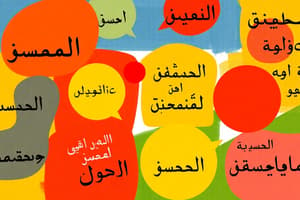Podcast
Questions and Answers
What are the three main varieties of Arabic?
What are the three main varieties of Arabic?
Classical Arabic (CA), Modern Standard Arabic (MSA), and Arabic Dialect (AD)
What is Classical Arabic also known as?
What is Classical Arabic also known as?
Quranic Arabic
What is the formal and sacred language of Islam?
What is the formal and sacred language of Islam?
Classical Arabic (CA)
What emerged in the 19th century as a linguistic commonwealth among the Arab nations?
What emerged in the 19th century as a linguistic commonwealth among the Arab nations?
What is the official language of several countries and serves as a medium of instruction in schools and academic institutions?
What is the official language of several countries and serves as a medium of instruction in schools and academic institutions?
What are Arabic dialects?
What are Arabic dialects?
What is diglossia in Arabic?
What is diglossia in Arabic?
Give an example of an Arabic dialect based on geographical regions.
Give an example of an Arabic dialect based on geographical regions.
How have Arabic dialects interacted with other languages over time?
How have Arabic dialects interacted with other languages over time?
What is the Gulf Cooperation Council (GCC) countries' relationship with Arabic dialects?
What is the Gulf Cooperation Council (GCC) countries' relationship with Arabic dialects?
What technique has been applied to Arabic language datasets to study the similarities and differences between dialects?
What technique has been applied to Arabic language datasets to study the similarities and differences between dialects?
Which model achieved the highest coherence in the comparative study of Arabic dialects using topic modeling?
Which model achieved the highest coherence in the comparative study of Arabic dialects using topic modeling?
What is the role of Arabic dialects in the interaction between languages?
What is the role of Arabic dialects in the interaction between languages?
What is Maltese, and how has it been influenced by Arabic?
What is Maltese, and how has it been influenced by Arabic?
What is the formal variety of Arabic in diglossia?
What is the formal variety of Arabic in diglossia?
What role can the study of Arabic dialects and their applications in text processing provide?
What role can the study of Arabic dialects and their applications in text processing provide?
Study Notes
Arabic Dialects
Arabic, a Semitic language, is spoken in various forms across the Middle East, North Africa, and other regions. It is the official language of 22 countries and is spoken as a first language, second language, or foreign language by around 300 million people. Arabic dialects are regional variations of the language that have evolved over time and are influenced by local cultures and traditions. In this article, we will explore the main varieties of Arabic and some key aspects of Arabic dialects.
Main Varieties of Arabic
Arabic has three main varieties: Classical Arabic (CA), Modern Standard Arabic (MSA), and Arabic Dialect (AD). Classical Arabic, also known as Quranic Arabic, is the formal and sacred language of Islam and serves as the basis for the Arabic script. Modern Standard Arabic is a standardized version of the language, which emerged in the 19th century as a linguistic commonwealth among the Arab nations. It is the official language of several countries and serves as a medium of instruction in schools and academic institutions.
Arabic Dialects, on the other hand, are the regional languages spoken by native Arabic speakers in various countries. These dialects are often classified based on geographical regions, such as the Levantine dialect, which includes those spoken in Lebanon, Syria, and Palestine, or the Egyptian dialect, which is specific to Egypt. Each dialect may have specific regional variations, but they all share a common foundation in the Arabic language.
Dialects in Contact with Other Languages
Arabic dialects have interacted with other languages over time, leading to the development of new forms and the influence of non-Arabic languages on Arabic. For example, Maltese, a Semitic language, has been influenced by Arabic and other languages, leading to the development of a unique variety of Arabic. Additionally, the use of Arabic as a second or third language by highly educated individuals in non-Arabic countries can lead to minor structural interference in the language, especially in religious writings.
Diglossia in Arabic
Diglossia in Arabic refers to the existence of two distinct forms of the language: the formal, standard variety (MSA) and the informal, colloquial variety (dialect). This phenomenon is common in many countries where Arabic is spoken and has led to a complex relationship between the written and spoken forms of the language. For instance, the Gulf Cooperation Council (GCC) countries, which include Saudi Arabia, Qatar, Bahrain, Kuwait, Oman, and the United Arab Emirates, have adopted MSA as the official language, but the main medium of instruction in schools is the local dialect.
Arabic Dialects in Text Processing
Topic modeling, a technique used to identify hidden themes in a collection of documents, has been applied to Arabic language datasets to study the similarities and differences between dialects. In a comparative study, researchers used six models (LDA, NMF, CTM, ETM, and two Bertopic variants) to analyze an Arabic dataset and found that the neural BERTopic model with a Roberta-based sentence transformer achieved the highest coherence, which was 36% above the second-best model. This suggests that machine learning techniques can be effectively applied to the study of Arabic dialects and may contribute to a better understanding of the linguistic phenomena in this language.
In conclusion, Arabic dialects are regional variations of the Arabic language that have evolved over time and are influenced by local cultures and traditions. They are an essential aspect of the Arabic language and play a significant role in the interaction between languages and the development of new forms of expression. As technology continues to advance, the study of Arabic dialects and their applications in areas such as text processing will provide valuable insights into the diverse and rich nature of the Arabic language.
Studying That Suits You
Use AI to generate personalized quizzes and flashcards to suit your learning preferences.
Description
Explore the main varieties of Arabic, including Classical Arabic, Modern Standard Arabic, and Arabic Dialects (AD), as well as the regional variations influenced by local cultures and traditions. Discover the complex relationship between the written and spoken forms of the language and the application of machine learning techniques in the study of Arabic dialects.




